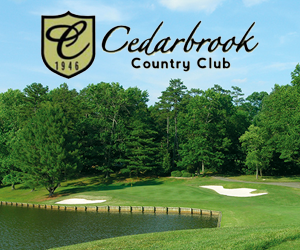Go ahead, weather. Get hot.
That’s the wish of officials at Reynolds Park Golf Course in Winston-Salem this summer, where the course owners and the city paid to tear up the old bentgrass greens and put in new Diamond Zoysia greens this spring.
Zoysia, much like the bermudagrass that’s been installed at many courses in the area during the past three or four years, enjoys warmer temperatures. In fact,it thrives in them. That means that, unlike in the previous 45 years – back to when the original, cool-weather bentgrass greens were planted when the course opened in the 1960s — Reynolds Park’s course managers are no longer dreading the summer.
“In July and August,” says Harold Kincaid, one ofthe general managers and owners and a head pro, “our superintendents and assistant superintendents are going
to sleep a lot better.”
There’s only been one problem so far – the first few weeks of June were actually cooler than expected.
That’s slowed the grow-in process, but still, everyone who comes to work here and play here acts like the greens are new toys out of wrapping paper.
The installation process took almost all of May to complete, and left the course struggling with few rounds played during the month. But the hope is that this is a decision for the long haul.
New Life Turf out of Norway, S.C., brought the sod and installed it. The company also laid the fairways and tees at Atlanta Athletic Club with zoysia before last year’s PGA championship. The Reynolds Park project started on April 23. That day, the course closed the back nine and
killed all greens on that side. The front nine remained open. For eight days, the project was on hold while the bentgrass died. Then, near the first of May, the new zoysia came in – rolled in on tractor trailers, 22 rolls on a tractor trailer, each weighing 1,600 pounds – and went down. On May 11, the back nine was done. On May 12, the front nine was shut down and killed, and all golfers moved to the back. The same process ensued, until the entire course
reopened on May 28. Many of the golfers who shied away then came back to see what had transpired on the public course.
“It was like a month-long aerification,” says Mark Hartis, one of Kincaid’s partners. “People will not play during aerification. And this was a little worse. But people were very understanding.”
During the process, Reynolds Park reshaped the greens on holes 4, 6, and 8. (Those greens were so severely sloped that, in the winter the dormant zoysia would’ve been so short that pin-placement options would’ve been limited.)
To people like Kincaid and Hartis, the headaches caused by losing a month’s worth of play – there were some complaints, but most people understood that the project was an act of progress – pale in comparison to the relief they’re about to feel. During the past few years,
which have produced brutal summers, Reynolds Park’s old greens struggled to keep up. At about this time last year, Kincaid says, they’d have been growing out the greens to try to avoid having the bentgrass die in the heat. Now, zoysia is a grass that thrives in it.
“If we still had our old greens, we’d be thinking about our spray schedule right now, and all the fungicides we’d have to put down,” Kincaid says. “We would be seeing when we’re going to raise the height of the greens. And now (with zoysia) we’re bringing them down.”
Reynolds Park modeled its project after Pilot Knob, which finished its transformation in May of last year. Kincaid says Pilot Knob now is running greens that are 9 or 10 on the Stimpmeter.
At Reynolds Park, New Life Turf put down a total of about 120,000 square feet of sod, which would cover nearly three acres if spread out. The sod came in rolls 21 inches wide, meaning it had seams.
Those seams are still growing together, and some of the greens still hop, but now everyone at Reynolds Park knows that the course will be fine, just as soon as the weather goes ahead and gets hot.

















